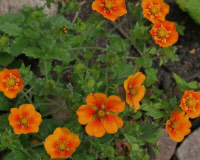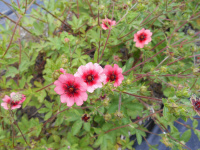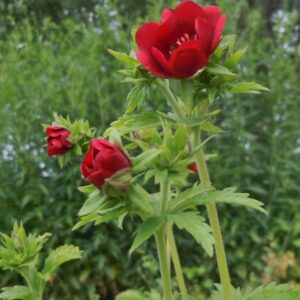Shop
Showing 585–592 of 788 results
-
Polystichum tsus-simense Korean Rock Fern Z 5-9
Compact, glossy, evergreen, narrow, arrow-shaped fronds with dark veins and black stems growing in a rosette.
Compact, glossy, evergreen, narrow, arrow-shaped fronds with dark veins and black stems growing in a rosette.
Size: 12-20” x 12-16”
Care: Shade to part shade in moist well-drained soil
Native: Korea
Wildlife Value: deer resistant
Awards: Royal Horticulture Society Award of Garden Merit. Great Plant Pick Elizabeth Carey Miller Botanic Garden1st collected “on the Island of Tsus Sima, in the Straits of Corea” by Charles Wilford (1836-18930 in 1859. Species Filicum, Vol. 4, p. 16 (1862) William J. Hooker. In 1854 Charles Wilford started as an assistant in the herbarium at the Royal Botanic Gardens, Kew. Sent to Asia in 1857 he collected plants in Hong Kong, moving to Taiwan the following year and to Korea and Japan in 1859.
-
Potentilla argyrophylla Cinquefoil Z 5-8
Sunshine colored saucers with orange centers in early summer
ARCHIVED
Note: This is a plant not currently for sale. This is an archive page preserved for informational use.
Sunshine colored saucers with orange centers in early summer
Size: 24” x 24”
Care: sun in well-drained soil
Native: Nepal, China, Pakistan & AfghanastanPotentilla is Latin meaning powerful referring to medicinal properties. Argyrophylla means silver leaved. Potentillas used by dentists in the 16th century to reduce pain according to Gerard, English herbalist. Per Culpepper, 17th century English herbalist potentilla is to be used if Jupiter is ascending and the moon is “applying to him.” This species collected by 1831.
-
Potentilla atrosanguinea Himalayan cinquefoil Z 5-8
Open pink cups in June-July
Open pink cups in June-July
Size: 18-24" x 24"
Care: Sun well-drained soil
Native: HimalayasPotentilla is Latin meaning powerful referring to medicinal properties. Potentillas used by dentists in the 16th century to reduce pain according to Gerard, English herbalist. Per Culpepper, 17th century English herbalist potentilla is to be used if Jupiter is ascending and the moon is “applying to him.” Atrosanguinea 1st collected in its native Nepal in 1822.
-
Potentilla hippiana Woody cinquefoil Z 4-8
Small clusters of yellow flowers atop fuzzy, toothed edged leaves
ARCHIVED
Note: This is a plant not currently for sale. This is an archive page preserved for informational use.
Small clusters of yellow flowers, July-August, atop fuzzy, toothed edged leaves
Size: 5-20” x 12"
Care: full sun in well-drained to moist well-drained soil
Native: Central & Southeast USA & much of Canada
Wildlife Value: Bee plantJohann Georg Lehmann (1792-1860) named this species in 1827 from a specimen collected by Edwin James in 1820 near the “sources of the Platte”. Carl Hippio was, in Weber’s words, “a revered colleague of Lehmann”
-
Potentilla nepalensis Nepal cinquefoil Z 5-9
Five-petal, open pink saucers with raspberry centers, blossom in small clusters atop leafless stems, above the clump of ground-hugging foliage. blooming in summer. “A fine species,” Liberty Hyde Bailey 1933.
Five-petal, open pink saucers with raspberry centers, blossom in small clusters atop leafless stems, above the clump of ground-hugging foliage. blooming in summer. “A fine species,” Liberty Hyde Bailey 1933.
Size: 1-2' x 12-18"
Care: sun in moist well-drained soil to well-drained soil
Native: Himalayan mountains1st described in 1822 in Exotic Flora, Vol. 2 p. 88, William Jackson Hooker. It flowered at the botanic garden in Edinburgh in 1823.
-
Potentilla porphyrantha Z 3-8
Bun of gray-green foliage sets off 7-petal pink blooms, medium pink in the center fading to light pink on the ends, surrounding a boss of stamens. Blooms in spring. One of our favorites.
Bun of gray-green foliage sets off 7-petal pink blooms, medium pink in the center fading to light pink on the ends, surrounding a boss of stamens. Blooms in spring. One of our favorites.
Size: 6” x 15”
Care: sun in moist well-drained to well-drained soil
Native: Caucasus Mountains in Armenia1st described for botany in 1940. Seems to be controversy among taxonomists about the plant’s name. Regardless, both the foliage and flowers make a beautiful little plant.
-
Potentilla rupestris syn. Drymocallis rupestris Rock cinquefoil, Siberian tea Z 5-8
White, single rose-like saucer flowers with prominent yellow stamens flowering atop leafless stems. Blooms in early summer.
White, single rose-like saucer flowers with prominent yellow stamens flowering atop leafless stems. Blooms in early summer.
Size: 10-20" x 12"
Care: sun to part shade in well-drained to moist well-drained soil
Native: Europe, Asia & mountains of western No. AmericaPotentilla is Latin meaning “powerful” referring to medicinal properties. Rupestris means “rock loving.” This species 1st identified in literature in 1650. Russians used the leaves to brew tea.
-
Potentilla thurberi Scarlet cinquefoil Z 5-9
Loose clusters of Cabernet-red saucers blooming atop tall stems, elevating the small saucer-like flowers to make them more visible. Blooms from June to September.
Loose clusters of Cabernet-red saucers blooming atop tall stems, elevating the small saucer-like flowers to make them more visible. Blooms from June to September.
Size: 30" x 12"
Care: full sun in well-drained soil
Native: Arizona & New MexicoPotentilla is Latin meaning powerful referring to medicinal properties. This species collected before 1880’s.






